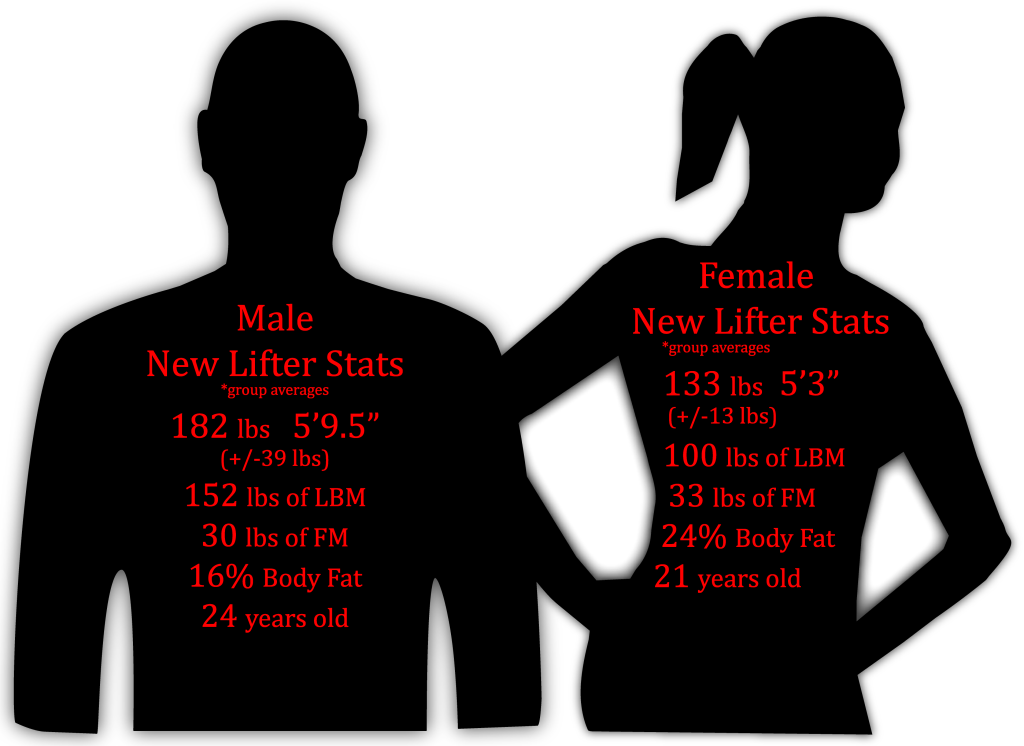Male & female filtered newbie gainz
In my previous post, I reviewed a study that examined the initial stages of muscle growth and strength development in new lifters. To recap, the researchers showed that neurologically driven strength gains occur right away during the first 2 months of lifting, before any muscle fiber growth occurs.
At the end of that post, I reminded readers that this lovely study involved both males and females. Yet, I said nothing of how the results broke down between the two groups. In today’s post, I will discuss that very topic. Did males and females differ in their response to the resistance training? Did one outperform the other in strength? Were there any hormonal differences?
Let’s find out!
Methods
For a fuller explanation, see my previous post. To briefly recap the methods, the researchers studied males and females new to lifting. There was one group that lifted 2 times a week for 8 weeks, focusing on their quad muscles. Another group did nothing.
The participants had the usual stats measured: weight, height, age, and body fat %. In addition to that, they had their 1RM tested, biopsies of their quads, and blood tests every 2 weeks. That allowed the researchers to examine the changes in the muscle tissues and in the hormones over the course of the study, rather than just at the start and end.
Results
As readers will recall from the previous post, the descriptive stats for the lifters did not change by the end of the study. The non-lifting control group also had no changes, in any way, over the course of the study (as expected). So, I won’t be mentioning the control group again. Below are the lifters’ stats. I’ve split them up by males and females. As always, they’re group averages and rounded to the nearest whole number for the ease of viewing.
Let’s look at what happened between the male and female lifters.
Strength, as measured by the 1RM, increased for all lifters across all time points. The greatest increases were in the first 2 weeks. Increases continued over the whole study, but the magnitude was not as great after the first 2 weeks. Because the researchers reported the strength stats in relative numbers, there’s no absolute weight numbers for me to report. Both males and females doubled their 1RM strength for all 3 lifts by the end of 8 weeks. When the researchers compared the strength of the lifters relative to their lean body mass, the females had about a 1 lb strength difference from the males. Even more, the relative strength of the females was shown as a percent of the relative strength of the males. For the squat, the females had 88% of the relative strength of the males by the end of the 8 weeks. For the leg press, the females had 107% of the relative strength of the males by the end. Yes. The females became stronger on a lb-per-lb basis in the leg press. For the leg extension, the females had 89% of the relative strength of the males.
As I explained in the last post, the biopsies of the quad muscles for both males and females showed no change in the CSA of the tissue…despite doubling their strength. The breakdown of fiber types changed over the course of the study for both the males and females. These neural changes occurred in the muscle fibers without changing the size.
Last, the researchers examined the hormonal profiles of the lifters. They found an increase in testosterone levels for the males only and a decrease in cortisol levels for the males only. Keep in mind that these changes were not dramatic. They were within normal physiological levels. We’re not talking about test changes that equated to a lifter taking DBol or anything. There were no other hormonal changes found, including no change in growth hormone levels.
Implications / Thoughts
As I explained previously, this study showed that in the first 2 months of newbie lifting, muscle fibers are not blowing up. Neural changes are what’s blowing up, for males and females. Longer term studies had and will go on to show that size gainz eventually come along for both males and females, but only after these rapid initial neural gainz.
If we recall, the only things that the blood analysis found was an increase in testosterone and a decrease in cortisol for the males. The females had no change in their blood hormones. YET, they too gained as much relative strength as the males! Were this a standard (the sad truth) study done with males alone, these blood analysis results could have been used to argue that the development of strength involves testosterone and cortisol changes. The researchers even showed a correlation between the changes in the fiber types and the cortisol levels for the males. But here we find that the inclusion of the other half of the population challenges that very thinking!
In the case of newbies, concerns over testosterone levels and stress cortisol levels be damned! Lift and ye will get stronger! This goes for females! Despite the smaller total size, smaller amount of LBM, higher body fat %, and lack of increased testosterone or decrease of cortisol, females developed their strength just as well as the males in this study!
In Conclusion
The researchers discussed phenotypic differences in the muscle tissue of males and females. Despite that and the “enhanced environment for growth,” the males did not increase their muscle size during the 8 weeks of the study and the females developed their relative strength just as much. In the case of early phase resistance training, the muscles of males and females seem to respond in the same way. Long term hypertrophy may very well result in differences that this study did not get into. The hormonal profile of the males implies that they may have increased hypertrophy over time. That, though, will take a different 12 week transformation style study to show. Until then, we can say that females initially develop their strength just as well as males do.
If you have any questions about this study or anything I said, please feel free to leave a comment. I will get back to you and others may have insight to offer, too. If you have any questions or topic suggestions that you would like answered as a post, then please email me at robert@analyticfitness.com.
Don’t forget to like Analytic Fitness on Facebook, or follow me on Twitter or the other social medias!






No Responses